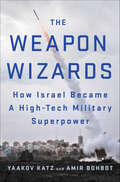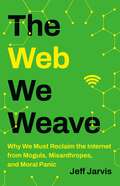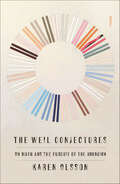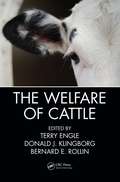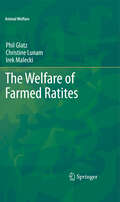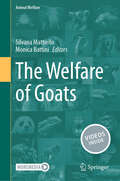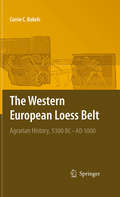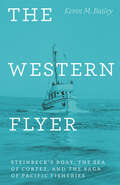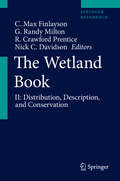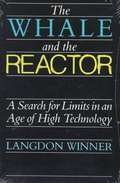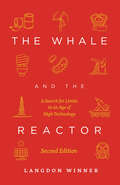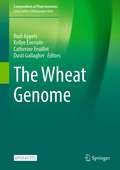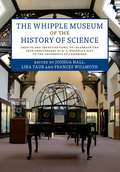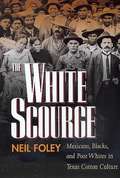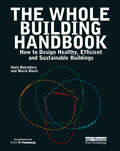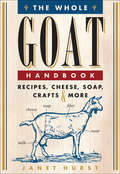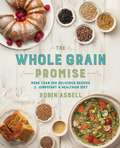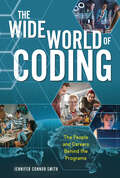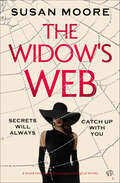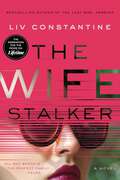- Table View
- List View
The Weapon Wizards: How Israel Became A High-Tech Military Superpower
by Amir Bohbot Yaakov Katz"A lively account of Israel's evolving military prowess...if The Weapon Wizards were a novel, it would be one written by Horatio Alger; if it were a biblical allegory, it would be the story of David and Goliath." —The New York Times Book ReviewFrom drones to satellites, missile defense systems to cyber warfare, Israel is leading the world when it comes to new technology being deployed on the modern battlefield. The Weapon Wizards shows how this tiny nation of 8 million learned to adapt to the changes in warfare and in the defense industry and become the new prototype of a 21st century superpower, not in size, but rather in innovation and efficiency—and as a result of its long war experience. Sitting on the front lines of how wars are fought in the 21st century, Israel has developed in its arms trade new weapons and retrofitted old ones so they remain effective, relevant, and deadly on a constantly-changing battlefield. While other countries begin to prepare for these challenges, they are looking to Israel—and specifically its weapons—for guidance. Israel is, in effect, a laboratory for the rest of the world. How did Israel do it? And what are the military and geopolitical implications of these developments? These are some of the key questions Yaakov Katz and Amir Bohbot address. Drawing on a vast amount of research, and unparalleled access to the Israeli defense establishment, this book is a report directly from the front lines.
The Weather Machine: A Journey Inside the Forecast
by Andrew BlumFrom the acclaimed author of Tubes, a lively and surprising tour of the infrastructure behind the weather forecast, the people who built it, and what it reveals about our climate and our planetThe weather is the foundation of our daily lives. It’s a staple of small talk, the app on our smartphones, and often the first thing we check each morning. Yet behind these quotidian interactions is one of the most expansive machines human beings have ever constructed—a triumph of science, technology and global cooperation. But what is this ‘weather machine’ and who created it? In The Weather Machine, Andrew Blum takes readers on a fascinating journey through an everyday miracle. In a quest to understand how the forecast works, he visits old weather stations and watches new satellites blast off. He follows the dogged efforts of scientists to create a supercomputer model of the atmosphere and traces the surprising history of the algorithms that power their work. He discovers that we have quietly entered a golden age of meteorology—our tools allow us to predict weather more accurately than ever, and yet we haven’t learned to trust them, nor can we guarantee the fragile international alliances that allow our modern weather machine to exist.Written with the sharp wit and infectious curiosity Andrew Blum is known for, The Weather Machine pulls back the curtain on a universal part of our everyday lives, illuminating our relationships with technology, the planet, and the global community.
The Web We Weave: Why We Must Reclaim the Internet from Moguls, Misanthropes, and Moral Panic
by Jeff JarvisA bold defense of the internet, arguing attempts to fix and regulate it are often misguided —"essential reading for anyone who cares about the future of the internet" (Taylor Lorenz, author of Extremely Online) The internet stands accused of dividing us, spying on us, making us stupid, and addicting our children. In response, the press and panicked politicians seek greater regulation and control, which could ruin the web before we are finished building it. Jeff Jarvis is convinced we can have a saner conversation about the internet. Examining the web&’s past, present, and future, he shows that many of the problems the media lays at the internet&’s door are the result of our own failings. The internet did not make us hate; we brought our bias, bigotry, and prejudice with us online. That&’s why even well-intentioned regulation will fail to fix hate speech and misinformation and may instead imperil the freedom of speech the internet affords to all. Once we understand the internet for what it is—a human network—we can reclaim it from the nerds, pundits, and pols who are in charge now and turn our attention where it belongs: to fostering community, conversation, and creativity online. The Web We Weave offers an antidote to today&’s pessimism about the internet, outlining a bold vision for a world with a web that works for all of us.
The Weil Conjectures: On Math and the Pursuit of the Unknown
by Karen OlssonA New York Times Editors' Pick and Paris Review Staff Pick"A wonderful book." --Patti Smith"I was riveted. Olsson is evocative on curiosity as an appetite of the mind, on the pleasure of glutting oneself on knowledge." --Parul Sehgal, The New York TimesAn eloquent blend of memoir and biography exploring the Weil siblings, math, and creative inspirationKaren Olsson’s stirring and unusual third book, The Weil Conjectures, tells the story of the brilliant Weil siblings—Simone, a philosopher, mystic, and social activist, and André, an influential mathematician—while also recalling the years Olsson spent studying math. As she delves into the lives of these two singular French thinkers, she grapples with their intellectual obsessions and rekindles one of her own. For Olsson, as a math major in college and a writer now, it’s the odd detours that lead to discovery, to moments of insight. Thus The Weil Conjectures—an elegant blend of biography and memoir and a meditation on the creative life.Personal, revealing, and approachable, The Weil Conjectures eloquently explores math as it relates to intellectual history, and shows how sometimes the most inexplicable pursuits turn out to be the most rewarding.
The Welfare of Cattle
by Bernard E. Rollin Terry Engle Donald J. Klingborg, DVMContains a selection of White Papers, commissioned to better inform the exploration of cattle welfare. These are prepared by notable experts in their field, to help provide factual context around selected topics that impact cattle welfare and production systems. Covers all aspects of cattle use in an accessible style, making this a must have volume for anyone interested in cattle welfare or cattle medicine. Provides an in-depth picture of the distinctive beef and dairy cattle welfare practices and issues, covering topics such as behavior, breeding and genetic manipulation, nutrition and feeding, housing and management, health and disease, and transport and slaughter. Written by acknowledged leaders in animal science, veterinary science, philosophy and animal welfare, presenting a truly multidisciplinary perspective on cattle welfare. Includes a section on understanding and managing animal welfare in both beef and dairy cattle, discussing how cattle perceive the world, animal handling and pain mitigation, and how to assure that the cows have a reasonably good life. The Welfare of Cattle offers an accurate, detailed account of the ethical and welfare concerns related to the human use of cattle. There is currently no significant book dealing with the welfare of cows, animals often seen as archetypal paradigms of 'farm animals'. Covering both beef and dairy cattle, the expert authors provide in-depth information on the husbandry roots of traditional agriculture, the replacement of this system of stewardship by an industrial model, and the resulting welfare challenges associated with industrial agriculture: feedlots, highly industrialized dairies, and slaughterhouses killing huge numbers of animals who have been transported great distances. This important book explores in detail the ways in which people who are providing care for cattle can take their first step, or their next step, toward enhancing the welfare of these animals. An extra chapter (online only) is available in the 'Downloads' tab on the left: Dairy Nutrition, by Michael Gamroth
The Welfare of Farmed Ratites
by Irek Malecki Christine Lunam Phil GlatzThis volume reviews, for the first time, the broad range of issues that affect the welfare of commercially farmed ratites. Although ratites incorporate several families of flightless birds this book focuses on the most commonly farmed ratites, the ostrich, emu and rhea. The readers are taken on a journey through all sectors of the industry, which include breeding, incubation, hatching, brooding, rearing, growth, transport and processing, with an emphasis on husbandry and management protocols that can impact bird welfare and health. Also discussed is the structure and sensory innervation of the skin and digits of the birds, and the potential welfare implications of industry practices on these structures. Each chapter in this volume focuses on a particular aspect of the commercial farming of ratites with contributing authors from a broad range of disciplines.
The Welfare of Goats (Animal Welfare #25)
by Silvana Mattiello Monica BattiniThis book focuses exclusively on the welfare of goats, which have peculiar behavioral characteristics and needs, and distinct individual personalities. Despite the many differences between goats and sheep, welfare and health issues of small ruminants have often been addressed together. Goats are extremely adaptable, now widespread and farmed all over the world. Usually bred for economic purposes (milk, meat and/or fibre), goats are also occasionally kept as pet animals, in educational farms, in zoos or for animal-assisted therapy. This wide range of conditions may elicit different challenges for their welfare. Readers of this volume are introduced to the goat species, starting from its origin and domestication process, and presentation of its natural behaviour and characteristics, including recent data on goats’ ability to communicate, cognition capabilities and personality. Knowledge of these features is indispensable to allow a welfare-friendly approach to goat management. The authors then address all relevant aspects of goat welfare, covering issues related to housing, feeding, painful procedures and end-of-life management, with special emphasis on welfare challenges in adverse environments. An additional chapter is dedicated to the main health problems that can jeopardize goats’ welfare. Finally, this volume highlights the latest research to on-farm welfare assessment with indicators and protocols for evaluation. This work will appeal to scholars of animal welfare science and biology, stakeholders in the livestock industry, as well as experts in goat-assisted interventions and pet owners. Video and audio files enrich the reading experience and can also be played from the print book using the free Springer Nature More Media app.
The Western European Loess Belt
by Corrie C. BakelsThis book deals with the early history of agriculture in a defined part of Western Europe: the loess belt west of the river Rhine. It is a well-illustrated book that integrates existing and new information, starting with the first farmers and ending when food production was no longer the chief source of livelihood for the entire population. The loess belt was chosen because it is a region with only one type of soil and climate as these are all-important factors where farming is concerned. Subjects covered are crops, crop cultivation, livestock and livestock handling, the farm and its yard, and the farm in connection with other farms. Crop plants and animals are described, together with their origin. New tools such as the plough, wheen, wagon and scythe are introduced. Groundplans of farm buildings, the history of the outhouse and the presence or absence of hamlets are presented as well, and the impact of farming on the landscape is not forgotten. The loess belt was not an island and the world beyond its boundaries was important for new ideas, new materials and new people. Summarising six millennia of agriculture, the thinking in terms of the Western European loess belt as one agricultural-cultural unit seems justified.
The Western Flyer: Steinbeck's Boat, the Sea of Cortez, and the Saga of Pacific Fisheries
by Kevin M. BaileyIn January 2010, the Gemini was moored in the Swinomish Slough on a Native American reservation near Anacortes, Washington. Unbeknownst to almost everyone, the rusted and dilapidated boat was in fact the most famous fishing vessel ever to have sailed: the original Western Flyer, immortalized in John Steinbeck's nonfiction classic The Log from the Sea of Cortez. In this book, Kevin M. Bailey resurrects this forgotten witness to the changing tides of Pacific fisheries. He draws on the Steinbeck archives, interviews with family members of crew, and more than three decades of working in Pacific Northwest fisheries to trace the depletion of marine life through the voyages of a single ship. After Steinbeck and his friend Ed Ricketts--a pioneer in the study of the West Coast's diverse sea life and the inspiration behind "Doc" in Cannery Row--chartered the boat for their now-famous 1940 expedition, the Western Flyer returned to its life as a sardine seiner in California. But when the sardine fishery in Monterey collapsed, the boat moved on: fishing for Pacific ocean perch off Washington, king crab in the Bering Sea off Alaska, and finally wild Pacific salmon--all industries that would also face collapse. As the Western Flyer herself faces an uncertain future--a businessman has bought her, intending to bring the boat to Salinas, California, and turn it into a restaurant feature just blocks from Steinbeck's grave--debates about the status of the California sardine, and of West Coast fisheries generally, have resurfaced. A compelling and timely tale of a boat and the people it carried, of fisheries exploited, and of fortunes won and lost, The Western Flyer is environmental history at its best: a journey through time and across the sea, charting the ebb and flow of the cobalt waters of the Pacific coast.
The Wetland Book: Distribution, Description, And Conservation
by Mark Everard Beth A. Middleton C. Max Finlayson Nick C. Davidson Kenneth Irvine Robert J. McInnes Anne A. van DamThe Wetland Book is a comprehensive resource aimed at supporting the trans- and multidisciplinary research and practice which is inherent to this field. Aware both that wetlands research is on the rise and that researchers and students are often working or learning across several disciplines, The Wetland Book is a readily accessible online and print reference which will be the first port of call on key concepts in wetlands science and management. This easy-to-follow reference will allow multidisciplinary teams and transdisciplinary individuals to look up terms, access further details, read overviews on key issues and navigate to key articles selected by experts
The Wetland Book: Distribution, Description, And Conservation
by C. Max Finlayson G. Randy Milton R. Crawford Prentice Nick C. DavidsonThe Wetland Book is a comprehensive resource aimed at supporting the trans- and multidisciplinary research and practice which is inherent to this field. Aware both that wetlands research is on the rise and that researchers and students are often working or learning across several disciplines, The Wetland Book is a readily accessible online and print reference which will be the first port of call on key concepts in wetlands science and management. This easy-to-follow reference will allow multidisciplinary teams and transdisciplinary individuals to look up terms, access further details, read overviews on key issues and navigate to key articles selected by experts.
The Whale and the Reactor: A Search for Limits in an Age of High Technology
by Langdon Winner"The questions he poses about the relationship between technical change and political power are pressing ones that can no longer be ignored, and identifying them is perhaps the most a nascent 'philosophy of technology' can expect to achieve at the present time. "—David Dickson, New York Times Book Review "The Whale and the Reactor is the philosopher's equivalent of superb public history. In its pages an analytically trained mind confronts some of the most pressing political issues of our day. "—Ruth Schwartz Cowan, Isis
The Whale and the Reactor: A Search for Limits in an Age of High Technology, Second Edition
by Langdon Winner“In an age in which the inexhaustible power of scientific technology makes all things possible, it remains to be seen where we will draw the line, where we will be able to say, here are possibilities that wisdom suggest we avoid.” First published to great acclaim in 1988, Langdon Winner’s groundbreaking exploration of the political, social, and philosophical implications of technology is timelier than ever. He demonstrates that choices about the kinds of technical systems we build and use are actually choices about who we want to be and what kind of world we want to create—technical decisions are political decisions, and they involve profound choices about power, liberty, order, and justice. A seminal text in the history and philosophy of science, this new edition includes a new chapter, preface, and postscript by the author.
The Wheat Genome (Compendium of Plant Genomes)
by Catherine Feuillet Rudi Appels Kellye Eversole Dusti GallagherThis open access book provides the first comprehensive coverage of the wheat genome sequence since the publication of the draft and reference sequences for bread wheat and durum wheat. It presents an overview and all aspects of the gold standard sequence of the bread wheat genome, IWGSC RefSeq v1.0 and its subsequent improvements through 2022 (IWGSC RefSeq v2.1), as well as the sequencing of multiple elite wheat varieties, durum wheat, and ancient wheat. The book provides a broad and extensive review of the resources, tools, and methodologies available for exploiting the wheat genome sequence for crop improvement and studying fundamental questions related to the structure, function, and evolution of the wheat genome. Wheat (Tritcum aestivum L.) is the most widely grown crop in the world, contributing approximately 20 percent of total calories and more protein in human diets than any other single source. This book is useful to students, teachers, and scientists in academia and industry interested in gaining an understanding of the wheat genome and its application as well as plant scientists generally interested in polyploid plant species.
The Wheel
by Richard W. BullietIn this book, Richard W. Bulliet focuses on three major phases in the evolution of the wheel and their relationship to the needs and ambitions of human society. He begins in 4000 B.C.E. with the first wheels affixed to axles. He then follows with the innovation of wheels turning independently on their axles and concludes five thousand years later with the caster, a single rotating and pivoting wheel. Bulliet's most interesting finding is that a simple desire to move things from place to place did not drive the wheel's development. If that were the case, the wheel could have been invented at any time almost anywhere in the world. By dividing the history of this technology into three conceptual phases and focusing on the specific men, women, and societies that brought it about, Bulliet expands the social, economic, and political significance of a tool we only partially understand. He underscores the role of gender, combat, and competition in the design and manufacture of wheels, adding vivid imagery to illustrate each stage of their development.
The Wheel: Inventions and Reinventions (Columbia Studies in International and Global History)
by Richard BullietIn this book, Richard W. Bulliet focuses on three major phases in the evolution of the wheel and their relationship to the needs and ambitions of human society. He begins in 4000 B.C.E. with the first wheels affixed to axles. He then follows with the innovation of wheels turning independently on their axles and concludes five thousand years later with the caster, a single rotating and pivoting wheel.Bulliet's most interesting finding is that a simple desire to move things from place to place did not drive the wheel's development. If that were the case, the wheel could have been invented at any time almost anywhere in the world. By dividing the history of this technology into three conceptual phases and focusing on the specific men, women, and societies that brought it about, Bulliet expands the social, economic, and political significance of a tool we only partially understand. He underscores the role of gender, combat, and competition in the design and manufacture of wheels, adding vivid imagery to illustrate each stage of their development.
The Whipple Museum of the History of Science: Objects and Investigations, to Celebrate the 75th Anniversary of R. S. Whipples's Gift to the University of Cambridge
by Liba Taub Joshua Nall Frances Willmoth†In this book the diverse objects of the Whipple Museum of the History of Science's internationally renowned collection are brought into sharp relief by a number of highly regarded historians of science in fourteen essays. Each chapter focuses on a specific instrument or group of objects, ranging from an English medieval astrolabe to a modern agricultural 'seed source indicator' to a curious collection of plaster chicken heads. The contributors employ a range of historiographical and methodological approaches to demonstrate the various ways in which the material culture of science can be researched and understood. The essays show how the study of scientific objects - including instruments and models - offers a window into cultures of scientific practice not afforded by textual sources alone. This title is also available as Open Access on Cambridge Core.
The White House Tapes: Eavesdropping on the President
by John PradosTranscripts of tape recordings beginning with Roosevelt.
The White Scourge: Mexicans, Blacks, and Poor Whites in the Cotton Culture
by Neil FoleyA powerful, award-winning work of social history about race, class and labor in Texas from post-civil war to the Depression.
The Whole Building Handbook: How to Design Healthy, Efficient and Sustainable Buildings
by Maria Block Varis BokaldersThe Whole Building Handbook is a compendium of all the issues and strategies that architects need to understand to design and construct sustainable buildings for a sustainable society. The authors move beyond the current definition of sustainability in architecture, which tends to focus on energy-efficiency, to include guidance for architecture that promotes social cohesion, personal health, renewable energy sources, water and waste recycling systems, permaculture, energy conservation - and crucially, buildings in relation to their place. The authors offer a holistic approach to sustainable architecture and authoritative technical advice, on: * How to design and construct healthy buildings, through choosing suitable materials, healthy service systems, and designing a healthy and comfortable indoor climate, including solutions for avoiding problems with moisture, radon and noise as well as how to facilitate cleaning and maintenance. * How to design and construct buildings that use resources efficiently, where heating and cooling needs and electricity use is minimized and water-saving technologies and garbage recycling technologies are used. * How to 'close' organic waste, sewage, heat and energy cycles. For example, how to design a sewage system that recycles nutrients. * Includes a section on adaptation of buildings to local conditions, looking at how a site must be studied with respect to nature, climate and community structure as well as human activities. The result is a comprehensive, thoroughly illustrated and carefully structured textbook and reference.
The Whole Goat Handbook: Recipes, Cheese, Soap, Crafts & More
by Janet HurstLearn how to select your animal, understand the breed, and how to use the products it will supply in this book written by a goat farmer for goat farmers. Goats are the hottest animal today to raise for hobby farmers, commercial farmers, and members of both 4-H and FFA. But using the products from a goat requires special skills, handling, and recipes. Here's The Whole Goat Handbook, chock full of recipes, crafting projects, advice, and more. Cooking with goat meat requires special, adapted instructions because the meat is so strong in flavor; there's no devoted goat-meat cookbook on the market—until now! Here as well are recipes for making cheese with goat milk as well as goat-milk soap. And for those raising goats for fiber, here are hard-won recommendations on crafting, knitting, and weaving. This book shows you how to do all this—and more.
The Whole Grain Promise: More Than 100 Recipes to Jumpstart a Healthier Diet
by Robin AsbellFrom quinoa to bulgar and millet to kasha, whole grains add a hearty, healthy, and flavorful boost to any meal. In The Whole Grain Promise, Robin Asbell shares quick and easy whole grain recipes that will entice the pickiest eater and appeal to the whole family. Whether you want to improve your health or try something new for dinner, whole grains are the perfect place to start. Beginning with the basics, Robin takes you through the major types of grains, their health benefits, and how best to cook them. From there, she offers more than 100 mouthwatering recipes that will encourage everyone to embrace the whole grain diet. With everything from Grain-Crust Spinach Cauliflower Quiche to Fudgy Brownie Cupcakes, The Whole Grain Promise will tempt your family with food that's not only healthy, but delicious!
The Wide World of Coding: The People and Careers behind the Programs
by Jennifer Connor-SmithThe best part about coding is that anyone with a computer can learn how to do it. From education to healthcare to entertainment, software touches almost every aspect of twenty-first century life. Take a high-level perspective on the types of people who create that software—including many jobs that do not involve writing code at all. Learn about the software development cycle and the huge variety of skills developers draw on, including psychology, mathematics, and art, to create amazing apps and programs. Explore why diversity is needed to prevent bias in design. Learn about the different coding languages and what they are used for, how developers choose a language, and tools that simplify coding. Jennifer Connor-Smith breaks down stereotypes about coding as a career that is open only to technology-obsessed gamers, revealing ways people use software to improve medical care, nurture dementia patients, promote social justice, and more. Hands-on activities show you how easy it is to learn to think like a coder. The next generation of coders will require diverse teams, creativity, and ethical codes of conduct to create the best and most successful software. Will you be one of them?
The Widow's Web
by Susan MooreWhen her tycoon husband suddenly dies, a woman discovers the sinister secrets of Silicon Valley, in this psychological thriller debut. When tech mogul Brad Jones is found drowned off the Marin coast, his death is quickly ruled a suicide. But his wife, Dr. Anna Jones, a renowned cyberpsychologist, isn&’t convinced. Driven by grief and suspicion, Anna begins to dig into Brad&’s past, uncovering some dark details behind Silicon Valley&’s elite. Anna soon crosses paths with Scott and Kristy Lyle, influential figures with connections reaching the highest echelons of the tech industry. The deeper she goes, the more she realizes Brad&’s death is tied to a long-buried secret—one that powerful people would kill to protect. Caught between the truth and some dangerous enemies, will Anna risk everything to expose the sinister forces at play?The Widow&’s Web is a gripping psychological thriller that explores ambition, betrayal, and the terrifying reality that our worst enemies may be those we trust the most. &“In TheWidow&’s Web, Susan Moore gives us the inside story of what really happens in Silicon Valley—not the start ups and IPOs but the depravity and decadence of the ultra-rich who despite all their wealth can&’t escape their own demons.&” —Karl Taro Greenfeld, journalist and award-winning author &“A gripping page-turner from start to finish, The Widow&’s Web is a mesmerizing blend of suspense and mystery, luring readers into a dark tangle of secrets with each unpredictable twist.&” —Lisa C. Carey, bestselling author &“Expertly plotted, gripping and impossible to put down.&” —Lorna Henderson, author of Two Sisters &“Susan Moore writes a compelling and heartbreaking psychological thriller about ordinary people making unimaginable choices. Her pared down narrative and attention to detail reminded me of Gillian Flynn.&” —Faiqa Mansab, award-winning author of This House of Clay and Water &“Intriguing and compelling.&” —Paul Perry, author of The Garden &“A superbly written tale of dark secrets, raging beneath a facade of sophistication and success.&” —Andy Elkerton, New York Times–bestselling author &“Susan is committed to creating exceptional stories with a far-reaching impact.&” —Gary W. Goldstein, producer of Pretty Woman &“Susan has a fantastic instinct for searing contemporary storytelling driven by intensely character driven plotting.&” —Katherine Lannon, Script Angel screenwriting coach
The Wife Stalker: A Novel
by Liv ConstantineSoon to be an original movie on Lifetime, premiering March 29!The bestselling author of The Last Mrs. Parrish—a Reese Witherspoon Book Club pick—returns with a psychological thriller, filled with chilling serpentine twists, about a woman fighting to hold onto the only family she’s ever loved—and how far she’ll go to preserve it.Named one of the most anticipated thrillers of the year by Goodreads, Bustle, SheReads, and Library Journal; A LibraryReads pick of the month Breezing into the upscale seaside paradise of Westport, Connecticut, gorgeous thirtysomething Piper Reynard sets down roots, opening a rehab and wellness space and joining a local yacht club. When she meets Leo Drakos, a handsome, successful lawyer, the wedding ring on his finger is the only thing she doesn’t like about him. Yet as Piper well knows, no marriage is permanent.Meanwhile, Joanna has been waiting patiently for Leo, the charismatic man she fell in love with all those years ago, to re-emerge from the severe depression that has engulfed him. Though she’s thankful when Leo returns to his charming, energetic self, paying attention again to Evie and Stelli, the children they both love beyond measure, Joanna is shocked to discover that it’s not her loving support that’s sparked his renewed happiness—it’s something else.Piper. Leo has fallen head over heels for the flaky, New Age-y newcomer, and unrepentant and resolute, he’s more than willing to leave Joanna behind, along with everything they’ve built. Of course, he assures her, she can still see the children.Joanna is devastated—and determined to find something, anything, to use against this woman who has stolen her life and her true love. As she digs deeper into Piper’s past, Joanna begins to unearth disturbing secrets . . . but when she confides to her therapist that she fears for the lives of her ex-husband and children, her concerns are dismissed as paranoia. Can she find the proof she needs in time to save them?
